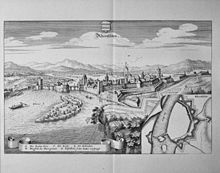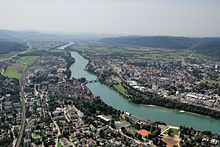Stein Castle (Rheinfelden)
| Stein Castle | ||
|---|---|---|
|
Model of the old castle on the "stone" |
||
| Alternative name (s): | Stein zu Rheinfelden; Burgstell | |
| Creation time : | 10th century | |
| Castle type : | Niederungsburg, island location | |
| Conservation status: | small remains of the wall | |
| Standing position : | Duke, Count | |
| Place: | Rheinfelden | |
| Geographical location | 47 ° 33 '17.4 " N , 7 ° 47' 22.6" E | |
| Height: | 280 m above sea level M. | |
|
|
||

The stone castle , even stone to Rheinfelden called, is a Outbound island castle in the Swiss town of Rheinfelden in the canton of Aargau . The castle was located on the "Inseli", an island off the city in the Upper Rhine . It formed part of the city fortifications of Rheinfelden .
situation
The castle on the Rhine island near Rheinfelden was called "stone" and can be found under this name in various documents. It was a strategically important point and for centuries it was considered impregnable. The rocky crest of the "Steins" on which the castle rose forms an island in the Rhine and rises five to six meters steeply above the level of the river. The river bed is clearly narrowed by the rock barrier, and next to the island it has a gorge-like depression, the so-called St. Anna Hole . Because of the increased flow speed of the Rhine at this point, ships could not dock above the castle.
Today the Rhine flows less rapidly near Rheinfelden because the river power stations (upstream the Rheinfelden hydropower station , downstream the Augst / Wyhlen barrage ) dam the water.
Underneath the rock made of shell limestone and overgrown with trees, an elongated gravel bank always forms through alluvial gravel . This could once have offered attackers the opportunity to approach the castle. The weak point was carefully considered when the castle was built, and so a mighty tower with walls made of four-meter-thick stone blocks was built on this side . Details about the construction of this tower are not known.
On its north side, the island forms a support point for the slightly angled Old Rhine Bridge .
history

In the 10th century, the Augstgau , the area in the acute angle between the Rhine and Aare , formed the northeasternmost tip of the Kingdom of Burgundy . Around this time, an aristocratic family settled in the area of what would later become the city of Rheinfelden, who had family ties to both the Burgundian royal family and the Salians . It owned estates on both sides of the Rhine, through which the border between the Burgundian Empire and the Holy Roman Empire ran at that time . Rudolf III. , the last Burgundy king, gave the Augstgau as a gift to Heinrich II. , the later Roman-German emperor. The Counts of Rheinfelden, subsequently named in this way, took on an important mediating role during this time of political upheaval and thus gained great influence. The most important representative was Rudolf von Rheinfelden , who ruled as Duke of Swabia from 1057 and was elected as the opposing king in 1077 , but died three years later in the battle of Hohenmölsen .
On the Inseli, which belonged to their own property , the Counts of Rheinfelden built Stein Castle in the 10th century. To secure the island castle on the land side, the "old castle" was also built on a rock terrace on the south bank. This was located in the western part of what would later become the old town - presumably at the point where the Schönauerhof and the Hugenfeld school house are today. However, archaeological evidence of the exact location has not yet been provided. Under the Zähringers , who inherited the Counts of Rheinfelden, a market town developed around the "old castle" and later the town. A ferry operated between the two banks of the Rhine and to Inseli . The first bridge over the Rhine is likely to have been built in the second half of the 12th century. It was secured on the one hand by the castle, on the other hand by an additional tower, the no longer existing «Böckersturm». The bridge was thus optimally protected against attackers.
With the death of Berthold V , the Zähringers died out in 1218 and Emperor Friedrich II from the House of Staufer immediately secured Stein Castle for the empire. In the same year Rheinfelden became an imperial city that did not belong to the county of Rheinfelden, which was administered from the castle. Pope Innocent IV excommunicated Friedrich's son Konrad IV in 1251. On July 28, 1252, he allowed Bishop Berthold von Pfirt to take possession of the castle (Castrum Rinvelden in medio Reni situm) in favor of the Prince Diocese of Basel . He justified this by saying that Frederick II did not acquire the castle for the empire, but for himself and his descendants. During the interregnum from 1254, the bishops also ruled over the city. Rudolf I from the House of Habsburg , elected king in 1273 , restored the previous legal situation. For several decades, Stein Castle was the main residence of the Habsburgs and the repository of imperial regalia ; In 1283 Rudolf issued the Rheinfeld house rules there .
Subsequently, various aristocrats from the immediate and wider area were entrusted with the office of burgrave , for example from the Baldegg and Rötteln families . In 1405 , Duke Friedrich IV, who was in dire financial straits, pledged the castle to Jakob Zibol , a wealthy Basel citizen. The Rheinfelder feared a military occupation by Basel and declared a feud in October 1409 years . They repulsed an attack in Basel and held the castle until the peace treaty in 1412. In 1418 King Sigismund combined the town and castle into one rule, which in 1439 was again owned by the Habsburgs. During the Old Zurich War , Rheinfelden was allied with Basel against the Habsburgs. From August 1445, Basel troops, together with Berners and Solothurners, besieged the castle. After four weeks the Habsburg occupation surrendered, the castle was then plundered and razed in February 1446 with the exception of a bridge tower and the chapel. After the Waldshut War, the Habsburgs pledged the whole of Front Austria to the Duchy of Burgundy . The new owners considered rebuilding the castle in 1471, for which they estimated costs of 3,000 guilders ; however, due to the Burgundian Wars , this never happened.
During the Dutch War , cannons were placed on the Inseli , which were used in 1678 to defend against a French army. In 1684 the Austrian government decided to build an artillery fortress there to reinforce the defenses. This was built until 1692 according to plans by the Innsbruck court architect Franz Martin Gumpp; the builder was Colonel Nicola Bertagnoni. The fort-like fortress, during the construction of which the old chapel was demolished, towered over all the roofs of the city and covered the entire island. In 1694 the fortress was provided with log houses , in 1715 it was reinforced with twelve pillars. When in September 1744, during the War of the Austrian Succession , a French army under Marshal Belle-Isle stood at the gates of the city, the Austrian garrison withdrew to the island fortress and capitulated after a few days of siege. On December 18, 1744, the French blew up the fortress, as well as the Böckersturm and other fortifications.
In 1843 the last ruins of the fort were cleared away. There is practically nothing left of the castle complex today. Only a small remnant of the former retaining wall on the southeastern part of the island, overgrown by plants, can be ascribed to the old fortification. Instead of the castle, a park was created on the Inseli around 1900.
Literary aftermath
In Friedrich Schiller's drama Wilhelm Tell (second act, second scene), “… zu Rheinfeld an des Kaiser Pfalz” means Stein Castle.
literature
- Walter Hochreiter, Eva Gschwind, André Salvisberg , Dominik Sieber, Claudius Sieber-Lehmann : Inside, outside, with you. History of the city of Rheinfelden . Ed .: City of Rheinfelden [Switzerland]. regional culture publisher, Ubstadt-Weiher 2014, ISBN 978-3-89735-800-3 .
- Karl Schib , community of Rheinfelden (ed.): History of the city of Rheinfelden. 1961.
Individual evidence
- ^ Hochreiter et al .: Inside, outside, there. Pp. 19-20.
- ^ Schib: History of the City of Rheinfelden. P. 23.
- ^ Hochreiter et al .: Inside, outside, there. P. 24.
- ^ Schib: History of the City of Rheinfelden. Pp. 43-44.
- ^ Hochreiter et al .: Inside, outside, there. P. 46.
- ^ Hochreiter et al .: Inside, outside, there. Pp. 48-50.
- ^ Schib: History of the City of Rheinfelden. Pp. 134-135.
- ^ Schib: History of the City of Rheinfelden. Pp. 246-249.
- ^ Hochreiter et al .: Inside, outside, there. P. 100.
- ^ Hochreiter et al .: Inside, outside, there. P. 152.
- ^ Friedrich Schiller: Wilhelm Tell. DigiBib.org, accessed March 10, 2015 .



